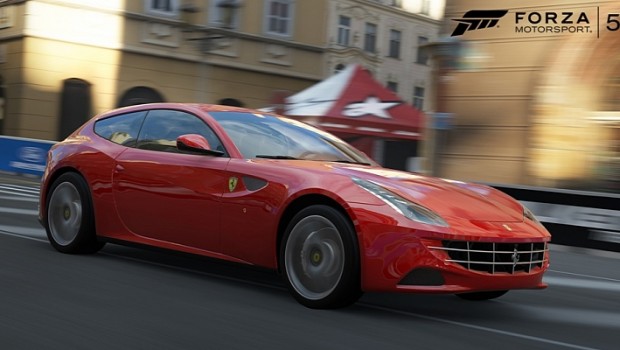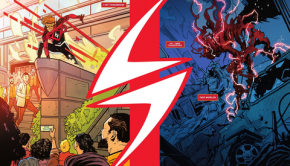Smoking Tire Car Pack Coming to “Forza Motorsport 5” on February 4th
Beginning Tuesday, February 5, “Forza Motorsport 5” fans can enter the driver’s seat in an impressive collection of ten new vehicles for the game, built from the ground up for the next-generation.
The Smoking Tire Car Pack includes high-profile sports cars ranging from the 1994 Nissan Fairlady Z Version S Twin Turbo to the 2011 Ferrari FF. The pack includes the 1968 Alfa Romeo 33 Stradale, which is delivered to your garage for use in all modes. Additional cars included in the pack are available for a la carte purchase in the marketplace and accessible using in-game credits or tokens once unlocked.
The Smoking Tire website was established in 2009 and has grown to become a respected media outlet featuring some of the best automotive content found online. With viral films, distinctive writing, and one of the most popular podcasts in the automotive world, The Smoking Tire represents the future of independent automotive journalism and humor.
Now let’s take a look at the cars found in The Smoking Tire Car Pack:
2013 Abarth Punto Supersport
Italian culture is synonymous with passion and nowhere is that better expressed than in their love for food and automobiles. Italian noodles become “pasta primavera” and an unassuming, economical city car becomes a hot hatch. Fiat’s performance division Abarth did its thing with the Punto Supersport and the result is all that and a side of marinara. Marking a return to the performance-driven Fiat subcompacts of the past like the 127 Sport and the Uno Turbo, the Punto Supersport is all about looking the role and then backing it up with an exhilarating ride. Exterior styling that screams, “I go fast!” meets a Garret-turbocharged 1.4-liter four-cylinder engine that makes the Punto SS do exactly that: go fast. Among hot hatches, the Punto SS will match up favourably against anything with three-doors out of Europe or America.
2000 BMW Z8
Most people’s first impression of the BMW Z8 was watching it get sawed in half by a helicopter in the James Bond film “The World is Not Enough.” Enthusiasts, however, first caught sight of the retro-chic roadster at the 1997 Tokyo Auto Show, where it was purely a design exercise called the Z07 Concept, celebrating the 50th anniversary of the BMW 507. That original V8-powered, aluminum-bodied roadster is exceedingly rare, since BMW only produced a few hundred. The response to the homage was so enthusiastic that BMW decided to go ahead and build it and, thankfully, the production car is almost identical to the lines Henrick Fisker created for the concept. While the Z8 is flush with classy retro touches like the banjo-spoke steering wheel and the center-position gauge cluster, the performance is entirely modern. Under the hood is the unparalleled drivetrain of the BMW M5 of the same era, meaning the Z8 has the same 400 horsepower to play with. Yet the Z8, being primarily made of aluminum, is also much lighter than the M5. So if the Z8 didn’t already have enough going for it, with stellar looks and unbeatable pedigree, it was also the fastest and best-handling BMW built up until its introduction — no small feat, and a perfect tribute to BMW’s often-underappreciated sense of style.
1994 Nissan Fairlady Z Version S Twin Turbo
Known as the 300ZX in North America, the Fairlady Z Version S Twin Turbo is the ultimate example of the original line of Z cars that began in 1969. Each new “Z” model evolved the concept; for example, the “Z31” dropped the inline engine in favour of a compact V6, with a single turbocharger in some variants. By the “Z32” generation, like this one, power and technology had flooded the concept, with the VG-series engine now packing variable valve timing, dual cams, and twin turbochargers. Car magazines loved the Z, and rightly so, as its combination of power, looks, and performance is captivating. Unfortunately, that performance came with a price (not helped out by exchange rates, which made getting the Z outside of Japan an expensive proposition). Even so, the Z sold well in North America, and was also available in a 2+2 variant, as well as a non-turbo model. Fast and desirable even today, the clean lines of the Z have aged gracefully. By the way, if those headlights look familiar, it’s because the second-generation Lamborghini Diablo used them under license.
2002 Pontiac Firebird Trans Am Ram Air
The last of the F-body Firebirds (an unbroken line going back to 1967) is a marriage of old-school muscle and modern power. That gives it some quirks, like anachronistic pop-up headlights and a decidedly last-century solid rear axle, but at least the latter is well-suited to drag-strip duties. The handling of this ‘bird is excellent by muscle car standards, pulling nearly 0.90 lateral G’s on a skid pad. More important for any Firebird connoisseur is straight-line G-forces, and with a 325-horsepower LS1 V8 under the hood snorkeling fresh, cold air through the functional Ram Air hood nostrils, those G’s are in abundance. That puts the Firebird in mid-13 second range for the quarter mile, and a whole ton of smoky, tail-happy fun on a road course. Excellent brakes help haul down the Firebird from speed, and a smooth six-speed keeps the engine on the boil — all benefits of being the ultimate development of the fourth generation F-body. While Pontiac is now resigned to that great junkyard in the sky, the final Firebird is a fitting tribute to Pontiac’s performance-driven heritage.
2011 Ferrari FF
How many cars could possibly need 290 kph-rated winter tires? The Ferrari FF is one of very few, and it was a game-changer for Ferrari. “FF” stands for Ferrari Four — namely, four seats and four-wheel drive. That means it’s a grand tourer that’s both practical for both everyday tasks and less everyday ones (such as conveying four of your closest friends up a snowy mountain pass at triple-digit speeds). Power — and lots of it — is provided by a Ferrari V12 mounted in the traditional up front position, making a cool 651 horsepower. From there, things get highly unconventional. First, there’s the Pininfarina shooting brake body style, a first for a production Ferrari. Then there’s another first, the all-wheel drive system known as “4RM” that’s 50 percent lighter than a traditional arrangement, utilising a small gearbox up front to transmit power directly from the crankshaft to the front wheels in low-traction situations. Translation: the system ensures that the FF has stupendous grip on nearly any surface which, combined with the near perfect weight distribution and ample power, will allow the FF to shock and delight up to four lucky occupants.
1968 Alfa Romeo 33 Stradale
One of the most beautiful cars ever built, the lightweight and powerful Alfa Romeo 33 Stradale also holds the record of being the most expensive new car sold in the U.S. of its time (at around $17,000). Initially as many as three of the extremely rare Stradale came to North America; today, only two remain on the continent. The car modeled for “Forza Motorsport 5” is part of one of the greatest private collections of Italian cars in the world. These cars were ahead of their time, using butterfly-style doors, large wrap-around glass, twin-spark ignition, dual-overhead cams, a six-speed Coletti transmission, and plenty of lightweight magnesium parts. As you start the two-liter V8 engine, it doesn’t take long to realize the powerplant is only inches behind your head. With an RPM redline of 9,500 — outrageous for 1968 — you hear a symphony of sound from rumble to scream.
1966 Chevrolet Nova SS
The Spanish translation of “Nova” means “no go,” which certainly has never applied to anything with the SS badge. It’s obvious the team at Chevrolet was going for the astronomical reference to a star’s brightness being on the rise. This early-bodied Nova is a hallmark of early American Muscle and would breed a loyal following of Nova lovers for generations to come. With the exception of the late 1980s re-badged Toyota Novas, the Nova has long been a favourite bow-tie model to hot-rod. In 1966, the Nova got a restyle that made it sportier and fell in with trends of the era. An almost fastback-like roofline, plenty of bright aluminum in the grill, and deck lid cove (as well as humped fenders) gave the Nova SS a distinctive look in the “compact” car genre. It could be fitted with any Chevy engine above the four-cylinder all the way up to the 350 horsepower Turbo-Fire 327 and matched with a close-ratio four-speed. Build your track-ready classic or drag strip rubber-burner, the Nova is ready to go wherever you take it.
2004 Maserati MC12
Homologation of race version cars has often brought the highest level of performance cars to the street. The Maserati MC12 is no different. Fifty cars were produced to homologate the #15 and two other race versions of the MC12. The stress-bearing chassis is fashioned out of a carbon fiber and Nomex honeycomb sandwich and follows the design of the Enzo Ferrari, although the MC12 is much larger and slightly slower. Marking the Trident’s return to racing after some 37 years, in 2005 the JMB Racing Maserati took second in the FIA Team Cup and Maserati won the Manufacturers Cup. Unfortunately, the MC12 was too wide to compete in the American Le Mans Series, but was allowed to race as a guest without the ability to earn points in the 24 Hours of Le Mans. There are no such rules in the world of Forza, so have at it and race it where you please; the only complaint you may get is to turn down the volume when the Masi hits its powerband.
1992 Toyota Celica GT-Four ST185
Toyota produced 5,000 GT-Four RC ST185’s to meet homologation requirements for Group A Rally competition. The 1992 racing version was named the “Carlos Sainz Edition” in honor of the Spanish driver’s racing achievements, including becoming Toyota’s first world rally champion in 1990. While this ST185 is not the racing version, it does deliver 10 more turbo-charged horsepower than the normal GT-Four for a total of 232 horsepower, and with its distinctive hood and front bumper the GT-Four RC is a much sought-after model.
1995 Audi RS 2 Avant
There’s no sound quite like the bark of a turbocharged inline five-cylinder, an unusual engine configuration that Audi first perfected in the legendary Audi Sport quattro. In the RS2, an evolution of that engine sits behind a face dominated by mesh grille inserts, flanked by a brace of projector headlights, and topped off with the signature Audi interlinked rings. The RS2 Avant was the very first Audi to wear the RennSport name, and the wagon body style was intentionally chosen to show off the company’s ability to produce a no-compromises vehicle that can blow the doors off many sports cars while comfortably conveying a family with a bunch of stuff from point A to point B. Most incredibly, its performance can shame a considerable number of newer high-performance cars, making it a legend in its own time and a fitting tribute to the Sport quattro’s legacy.
For more information on the cars included in The Smoking Tire Car Pack for Forza Motorsport 5, please visit www.ForzaMotorsport.net.
For assets related to the Smoking Tire Car Pack, please visit this post on Xbox Wire.







